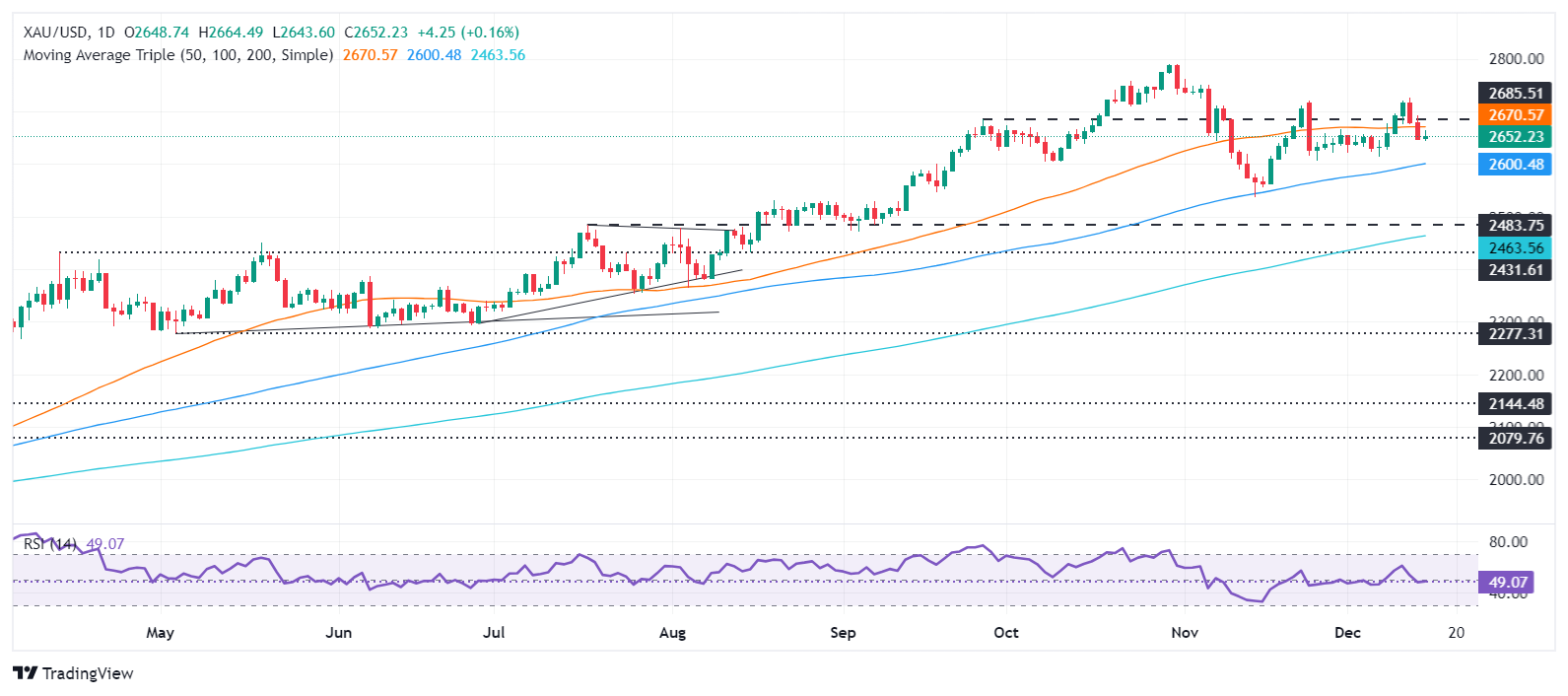Gold price stays firm on Monday as market awaits FOMC meeting
- Gold prices increase despite a slight rise in the US Dollar following mixed PMI data.
- Investors await the Fed’s interest rate decision and economic projections, expecting a 25 bps cut on Wednesday.
- The market speculates on the Fed's future monetary policy amid potential inflationary pressure from Trump policies.
Gold prices edge slightly higher during the North American session at the beginning of the week, up by 0.28%, as investors await the Federal Open Market Committee (FOMC) decision. At the time of writing, the XAU/USD trades at $2,643, above its opening price but off the highs of the day.
The US economic docket remains light with the release of S&P Global Flash PMIs for December, which came mixed. Business activity in the manufacturing sector weakened after improving last month, while the services sector printed its highest reading in 2024.
The data lifted the Greenback, which according to the US Dollar Index (DXY) rose 0.07% to 107.01. Meanwhile, Bullion dipped from daily highs of $2,664.
The Federal Reserve (Fed) will meet for the last time this year on December 17 and 18. Estimates suggest the Fed will cut interest rates by 25 basis points, but traders are eyeing the release of the Summary of Economic Projections (SEP) to grasp the path of interest rates in 2025.
Lower interest rates are usually a tailwind for the non-yielding metal. However, there is growing speculation that the Fed might adopt a gradual stance as the upcoming Trump administration hints at inflation-prone fiscal policies.
Gold prices tend to rise in lower rate environments and with higher geopolitical risk, which have both subsided of late.
The US economic docket will feature the release of Retail Sales, Industrial Production, the FOMC policy decision, and the release of the core Personal Consumption Expenditures (PCE) Price Index.
Daily digest market movers: Gold price holds firm near $2,650
- Gold prices plunged as US real yields are pressured, falling two basis points to 2.049%, a tailwind for the precious metal.
- The US 10-year Treasury bond yield drops two and a half basis points to 4.375%.
- The US Dollar Index remains firm at 107.05, virtually unchanged.
- S&P Global Manufacturing PMI for December dipped from 49.7 to 48.3, missing estimates of 49.8.
- S&P Global Services PMI for the same period expanded by 58.5, up from 56.1, above forecasts of 55.7.
- The CME FedWatch Tool suggests that traders had priced in a 96% chance of a quarter-point rate cut on Wednesday.
- For 2025, investors are betting that the Fed will lower rates by 100 basis points.
- Analysts at Goldman Sachs noted that China’s central bank “may even increase Gold demand during periods of local currency weakness to boost confidence in their currency.”
Technical outlook: Gold price retreats, sellers eye 100-day SMA
The Gold price uptrend remains intact, yet trades off last week’s lows beneath the 50-day Simple Moving Average (SMA) of $2,670. The Relative Strength Index (RSI) breached below its neutral line, indicating that sellers are in charge.
If Gold prices drop below $2,650, the next support would be the 100-day SMA at $2,600. On further weakness, the next stop would be the August 20 peak at $2,531. Conversely, if XAU/USD rallies past $2,650, the next resistance would be the 50-day SMA at $2,670, ahead of $2,700.

Gold FAQs
Gold has played a key role in human’s history as it has been widely used as a store of value and medium of exchange. Currently, apart from its shine and usage for jewelry, the precious metal is widely seen as a safe-haven asset, meaning that it is considered a good investment during turbulent times. Gold is also widely seen as a hedge against inflation and against depreciating currencies as it doesn’t rely on any specific issuer or government.
Central banks are the biggest Gold holders. In their aim to support their currencies in turbulent times, central banks tend to diversify their reserves and buy Gold to improve the perceived strength of the economy and the currency. High Gold reserves can be a source of trust for a country’s solvency. Central banks added 1,136 tonnes of Gold worth around $70 billion to their reserves in 2022, according to data from the World Gold Council. This is the highest yearly purchase since records began. Central banks from emerging economies such as China, India and Turkey are quickly increasing their Gold reserves.
Gold has an inverse correlation with the US Dollar and US Treasuries, which are both major reserve and safe-haven assets. When the Dollar depreciates, Gold tends to rise, enabling investors and central banks to diversify their assets in turbulent times. Gold is also inversely correlated with risk assets. A rally in the stock market tends to weaken Gold price, while sell-offs in riskier markets tend to favor the precious metal.
The price can move due to a wide range of factors. Geopolitical instability or fears of a deep recession can quickly make Gold price escalate due to its safe-haven status. As a yield-less asset, Gold tends to rise with lower interest rates, while higher cost of money usually weighs down on the yellow metal. Still, most moves depend on how the US Dollar (USD) behaves as the asset is priced in dollars (XAU/USD). A strong Dollar tends to keep the price of Gold controlled, whereas a weaker Dollar is likely to push Gold prices up.

